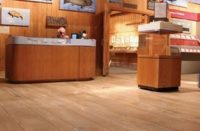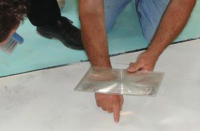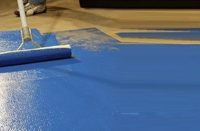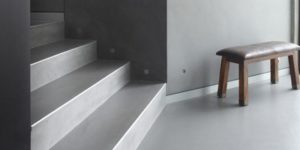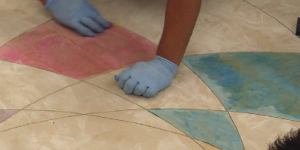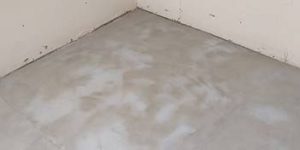Diamonds are forever, or so they say. But not so much with building interiors where diamonds and other luxury items are displayed and sold. Hence, the need for sophisticated concrete floors using microtoppings.
Take the case of the legendary Tiffany & Co. and its longtime flagship store on Fifth Avenue in the bustling Midtown East district of Manhattan. The center of Tiffany’s jewelry and specialty high-end retail universe for 70 years, the store closed recently for its first major renovation in decades.
But before this intermission began for the setting of Truman Capote’s novel and subsequent 1961 movie “Breakfast at Tiffany’s,” a good deal of the action was taking place offstage — as in an adjacent building — in late 2019.
There, Tiffany’s has set up shop, for the next two years or so. They started referring to the building as Tiffany’s Pop-Up store or Tiffany Flagship Next Door. For several months in 2019, the store’s interior was the center of frenzied activity by a group of construction tradespeople scrambling to transform the space into Tiffany’s Pop Up/Flagship Next Door. Among those on the front lines of this campaign was Majestic Flooring Solutions Corp.
Frenzied perhaps, but not haphazardly executed, says Aaron Poelker, Majestic Flooring Solutions president. The client, designers CallisonRTKL, and general contractor Structure Tone set a high bar for appearance and performance in the flooring system that Poelker offered as the best option for this daunting project — installing a new flooring system on levels one through four, all of which looked out into an atrium space.
“The designers wanted a Cadillac floor at Chevy prices,” Poelker says. A familiar request for any contractor, perhaps, but the Caddy-quality request was for real. This is Tiffany’s, after all, he adds, “So everything has to be perfect.”
Going for subtly
The flooring option that eventually won out — a system composed of an epoxy mortar basecoat and a sprayable microtopping topcoat — was proposed after Poelker had floated several other possibilities. It’s aim was to deliver sophisticated concrete floors using microtoppings.
Going in, the design team wanted a polished concrete look. A far too costly option was to remove existing flooring of engineered wood and terrazzo to make way for concrete. Hand-troweled concrete over the existing flooring got a hearing. But after sampling with several colors and borders, this kind of surface exhibited “too much movement,” Poelker says. The design team couldn’t settle on any of these.
Finally, Poelker reached back into his project portfolio and pulled out a microtopping system he had used successfully in previous jobs. The Arapido sprayable cementitious polished concrete microtopping from Düraamen Engineered Products Inc. Following a sample review and an on-site mockup using the complete system of epoxy slurry basecoat and microtopping topcoat, this approach got the OK. The system can be installed over various existing substrates, including the wood and terrazzo combination found on Tiffany’s four levels.
By adding ground-up mica and marble to the microtopping, a contractor can create a monolithic look or a slightly mottled look with subtle movement, Poelker says.
A multifaceted, multistep process
The project started with extensive surface preparation that involved grinding the existing terrazzo in the center of the floors. It also meant sanding the wood flooring on the perimeter. A fiberglass scrim was installed along the joints where terrazzo met wood, to serve as reinforcement to prevent buckling or cracking of the new flooring above.
Flooring installation began with troweling a high-strength epoxy slurry, made from epoxy and silica products from Elite Crete Systems. Following an overnight dry, they repaired, touched up, sanded and cleaned the epoxy surface. Then they applied Duraamen’s CP100, an acrylic copolymer primer.
Contractors applied a second primer coat the next day, followed by the sprayable microtopping. When dry, they polished the surface with 100-grit resin pads.
Border and inlay areas of the floor were highlighted in black, using Düraamen’s Deso Dye concentrate in acetone.
Broadcasting a blend of finely graded aggregates and minerals called “Cast-on,” also from Düraamen, added a flourish to the surface’s appearance. The blend, scattered on the still wet microtopping, produces a marbleized polished concrete with a creamy salt-and-pepper look. Reports say that the material will boost the floor’s abrasion resistance.
Next, the process continued with a mist coat of the CP1000 acrylic copolymer sealer. It was then followed by a flood coat of CP1000 and a final topcoat of Düraamen’s Perdure U90 moisture-cured polyurethane.
All the flooring system’s components totaled ¼” or less in applied thickness, and the math mattered. The thinness meant elevator and escalator saddles could remain, along with the railing system’s base at the atrium edge.
Faced with an unyielding project schedule, Majestic Flooring Solutions crews would start on the next level’s floor while still completing the level below. It took one week to complete the multiple steps for each level’s floor, with the total project taking four.
The impossible made possible
Producing a floor that could meet Tiffany’s high standards on a tight deadline was a stern challenge, Poelker says. Add to that the logistics of working in a crowded, fast-paced mid-Manhattan setting. Not to mention moving the material and equipment for 18,000 square feet of floor in that environment without disrupting traffic and pedestrian flow.
“We had countless meetings with the design and GC team, discussing what they wanted and what we needed to make it happen,” Poelker says. Sampling, R&D, planning and scheduling for the project started a year before work got underway.
 Then there was the technical side of the equation — ensuring that preparation was optimal, with no room for the slightest imperfections, as they would be visible in a complex, multicomponent flooring system that was ¼ inch or less thick. That meant keeping other trades off the floor. It also meant “walking around in our socks” during installation, Poelker says with a laugh.
Then there was the technical side of the equation — ensuring that preparation was optimal, with no room for the slightest imperfections, as they would be visible in a complex, multicomponent flooring system that was ¼ inch or less thick. That meant keeping other trades off the floor. It also meant “walking around in our socks” during installation, Poelker says with a laugh.
The future for Tiffany’s Flagship Next Door isn’t certain after the real flagship’s renovation is complete. The design team and Majestic Flooring Solutions viewed the project with the same expectations as any high-end job. Which meant installing a high-performance, visually intriguing, long-term flooring system up for any service the future may bring.
“It was a monumental task with an aggressive time frame. You’re saying to a major general contractor and a store like Tiffany’s that you can do the impossible,” Poelker says as he reflected on the project’s demands as well as its rewards. “And then to hear, ‘wow, they really did it.’”
Project at a Glance
Project: Tiffany’s Pop-Up/Store Next Door, New York, New York
Decorative Concrete Contractor: Majestic Flooring Solutions, Ronkonkoma, New York
General Contractor: Structure Tone, New York
Architect: CallisonRTKL, New York
Owner: Tiffany & Co.
Key materials: Düraamen Engineered Products’ CP1000 acrylic copolymer primer, Arapido cementitious microtopping, Deso Dye, Cast-on aggregate blend and Perdure U90 polyurethane sealer; and Elite Crete Systems’ epoxy and silica slurry.
Scope of project: Preparing existing terrazzo and engineered wood flooring surface; installing multicomponent seamless flooring system on four floors of building.
Biggest challenges: Exhaustive investigation and selection of flooring system meeting stringent requirements of owners and designers; logistics in crowded, busy Midtown Manhattan business district; coordination with other trades; accelerated timetable; thorough preparation of existing wood and terrazzo flooring; installing low-thickness flooring system without imperfections over existing floor.
